A82 PulpitRock Improvement Environmental Statement Non-Technical Summary September 2010
This document is also available in pdf format (1.4Mb)
INTRODUCTION
An Environmental Statement (ES) has been prepared on behalf of Transport Scotland for improvement works to the A82 at Pulpit Rock.
This Non-Technical Summary forms part of the A82 Pulpit Rock Improvement Environmental Statement, September 2010 and provides supporting information for the publication of draft Statutory Orders.
The Non-Technical Summary (NTS) describes the Scheme and summarises in non-technical language the Environmental Statement that has been prepared in accordance with the Environmental Impact Assessment (Scotland) Regulations 1999.
NEED FOR THE SCHEME
The A82 is the main road link from Glasgow and the Central Belt to Fort William, the Highlands and the Western Isles. Consequently, the A82 route is an important part of the Scottish Trunk Road network and efficient operation of the road is essential for access to the Highlands and Islands.
Between Tarbet and Crianlarich, the A82 is generally rural in nature and consists of a single 2-lane carriageway of varying standards. The principal communities along this section of the route are Tarbet, Ardlui and Crianlarich, as shown in Figure 1 - Location Plan.
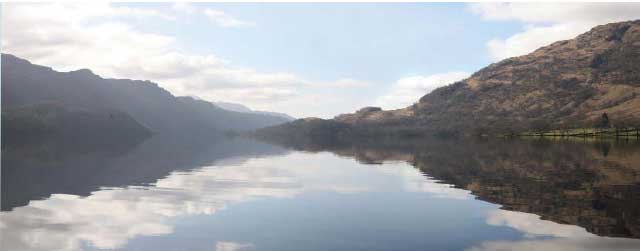
This stretch of the A82 is less than 7.3m wide and many sections do not have hardstrips or verges. Its tortuous geometry is well recognised and results in considerable delays to road users, particularly when a high number of tourists are attracted to the route during the summer months and when heavy goods vehicles are required to negotiate the tight horizontal bends and narrow carriageway width.
Following a Route Action Plan Study of the A82 between Tarbet and Fort William, in 2006, the Scottish Ministers announced the commencement of design work for improvements to the A82 at Pulpit Rock. This improvement will remove the notorious bottleneck at Loch Lomond and the traffic lights which have been there for over 30 years.
BACKGROUND
An option assessment was carried out in accordance with the requirements for Stage 2 Assessment given in the Design Manual for Roads and Bridges (DMRB). The Options and the methodology and findings of the Stage 2 Assessment are described in full in the Stage 2 Scheme Assessment Report. Initially, a wide range of preliminary scheme options were developed for consideration. From this a number of options were brought forward for further detailed assessment from which a preferred Scheme was selected.
THE PROPOSED SCHEME
The Scheme provides improvements over a length of approximately 400m. It is a partly offline solution, providing a new viaduct which runs in parallel to the loch shoreline for approximately 180m. North of the new viaduct the existing carriageway is widened by cutting into the existing rock headland. The improvements to the existing road will extend approximately 180m to the north of the new structure. Tie-in works will be required in advance of the start and end of the Scheme covering approximately 20m at each location.
The viaduct section will consist of a 6m carriageway plus 1.2m curve widening, with a verge of 1m on the west side and 2m on the loch side. North of the viaduct improvements to the existing carriageway will consist of a 6m carriageway with varying curve widening, a 1.5m verge on the west side and a 1.05m verge on the east side. The preliminary design for the Scheme is shown in Figure 2 — The Scheme.
SCOPING STUDY
A Scoping Report was produced and circulated to statutory bodies including Loch Lomond and Trossachs National Park Authority, Scottish Natural Heritage, Scottish Environment Protection Agency and Historic Scotland. In addition, the scoping report was also circulated to a wide number of non-statutory bodies including the relevant Community Councils and local businesses. The scoping report discussed the environmental issues to be addressed in the Environmental Statement and allowed all consultees to comment on these issues and any further issues they felt should be addressed. It was determined that Traffic Noise and Vibration, Air Quality, Vehicle Travellers and Geology and Soils should all be scoped out of the Environmental Impact Assessment. However, noise and air impacts during the construction period should be addressed within the Disruption due to Construction Chapter.

ENVIRONMENTAL ASSESSMENT
Policies and Plans
The proposed Scheme is supported by policies in the Argyll and Bute Structure Plan (2002), the Loch Lomond and the Trossachs National Park Plan 2007 — 2012, the adopted Dumbarton Wide Local Plan (1999), the Loch Lomond and Trossachs National Park Finalised Draft Local Plan (February 2010) and Argyll and Bute’s Local Transport Strategy 2007-2010. All of the above policy documents identify the A82 north of Tarbet as a strategic priority and, in particular, Pulpit Rock as an area in need of improvement works.
In addition, the policy documents highlight a number of other policies that the Scheme must conform to, particularly those relating to landscape and nature conservation, and these policies have been taken into account in the Environmental Assessment.
The A82 Pulpit Rock Improvement Scheme is supported by policies to improve the A82 Trunk Road. The Scheme is also supported by policies of road safety and access and the protection of the local environment. The development of the Scheme will not jeopardise any committed development opportunities. However, there are likely to be policy impacts relating to local landscape character and biodiversity issues, though these will be alleviated through appropriate mitigation measures, which are outlined under the relevant headings in this NTS.
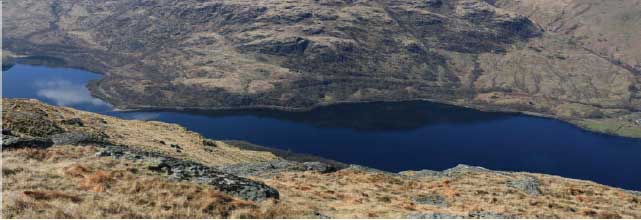
Landscape and Visual Effects
The site is located within landscape of the highest quality in Scotland. The study area is located within the National Scenic Area and within Loch Lomond and the Trossachs National Park. Pulpit Rock itself is a Scheduled Monument. The site is located towards the north end of the loch where it is surrounded by high ground and a number of summits on both sides of the glen. The wider landscape is large scale and rugged. There is dense broad-leaved semi-natural woodland right down to the shoreline, with very little break in the tree cover. The road runs along the shoreline and the semimature vegetation either side of the road gives it character.
The most significant landscape effects of the Scheme will be those caused by the introduction of the viaduct which will be supported by piers within the Loch and the treatment of the rock promontory. Treatments would include clean cut slopes, areas with rock bolts and netting and other stabilising treatments. The Scheme also includes the introduction of a drainage swale and access maintenance track and an area of fill within the vicinity of Pulpit Rock to bring up the ground level for the widening of the existing road.
Even though the individual elements of the Scheme would be prominent, the Scheme would affect a relatively small section of the wider landscape. The National Scenic Area designation will not be compromised and the special qualities of the National Park landscape will not be significantly affected. The landscape setting of Pulpit Rock will be changed but not significantly adversely affected.
The zone of visual influence is determined by the topography and is relatively restricted to the section of the valley within which the site is located. However the site can be seen from a wide area from the Loch itself and the opposite bank of Loch Lomond. It is visible from the West Highland Way and also from the hillsides and summits on the east side of the Glen. There are approximately three residential properties that will experience moderate/slight effects.
The largest receptor group is the vehicle travellers and the experience of travelling the A82 will change. The road will have a more heavily engineered character but this will be offset by the opening up of views with the removal of vegetation and the introduction of the viaduct which will swing travellers out over the Loch. The effects for this receptor group will be major/moderate beneficial. Mitigation has been taking place throughout the project and several options were explored and adapted before the preferred option was selected. The design of the viaduct has been developed to minimise the number of piers and to produce a slender curving structure to follow the profile of the shoreline. Mitigation for the rock cut and the ground works will comprise planting with native species of local provenance and the establishment of vegetation to blend with the existing upland plant community.
Land Use
The existing primary land use within the Scheme study area is woodland interspersed with areas of rough grazing with broadleaved semi woodland located immediately on either side of the A82 at Pulpit Rock. The Scheme study area is bounded on the east and north east by Loch Lomond and by the main Glasgow to Forth William railway line to the south west.
There are no properties within 200m of the Scheme; the closest properties are Stuckendroin over 800m to the north and Ardvorlich over 1400m to the south.
The impacts on land use as a result of the Scheme will be limited. While the construction will necessitate the land take of some areas of rough—grazing land, this has limited agricultural value due to its topography and soil quality. Furthermore, this land also has minimal grazing potential. Small areas of semi-natural broad-leaved woodland will be required but mitigation planting should ensure the impact of this land take is kept to a minimum.
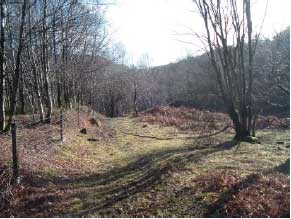
Cultural Heritage
There is one Scheduled Monument within 250m of the proposed Scheme route: Pulpit Rock preaching site. A second Scheduled Monument, Island I Vow Castle and Settlement, is situated c.1km from the site. Island I Vow Castle is also protected as a Listed Building.
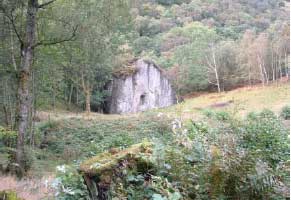
The National Monument Record of Scotland and the Sites and Monuments Record, both held by the Royal Commission on Ancient and Historical Monuments of Scotland, contain records for both Scheduled Monuments, together with one further site within 200m of the Scheme - the Tarbet to Crianlarich Military Road.
It is possible that additional buried remains of archaeological significance survive along the line of the proposed road, although it is considered here that the likelihood of encountering such remains is low.
No direct effects are predicted to occur on the identified cultural heritage assets as a result of the construction of the proposed road improvements.
No significant residual effects are anticipated in relation to cultural heritage interests and the development proposals are considered to conform to the aims of national, regional and local planning policy as regards cultural heritage.
The scheduled area around Pulpit Rock must be avoided by the proposed development and associated construction traffic and construction compounds. Historic Scotland require that there should be no ground disturbance within the scheduled area, and, if possible, within a 20m zone outside the scheduled area. Therefore, the site will be protected by fencing during construction work and the course and nature of that fencing will be agreed with Historic Scotland prior to construction.
Ecology and Nature Conservation
Ecological surveys were conducted and comprised Phase 1 habitat survey, National Vegetation Classification, lower plants, invasive plants, aquatic macrophytes, bats, red squirrel, water vole, pine marten, badger, otter, wildcat, breeding birds and fish. An ecological desk study and assessment of existing protected sites and species data was also undertaken.
The nearest statutory designated sites for nature conservation are Ben Vorlich Site of Special Scientific Interest and Pollochro Woods SSSI (a component site of Loch Lomond Woods Special Area of Conservation). Neither SSSI would be affected by the Scheme.
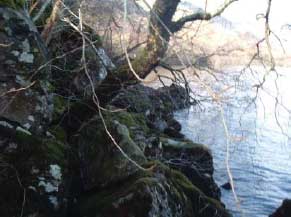
To address Article 6 of the Habitats Directive, screening for Appropriate Assessment (which assesses if a development has the potential to result in significant effects on a Special Area of Conservation or Special Protection Area) was undertaken in consultation with Scottish Natural Heritage to examine the ecological impacts upon nearby Natura 2000 sites. It was concluded that the Scheme will not have a significant effect on Loch Lomond SPA/Ramsar, Endrick Water SAC or the western oak woodland qualifying feature of Loch Lomond SAC due to large separation distances between the Scheme and these European sites, but it will have a significant effect on the otter qualifying feature of Loch Lomond Woods SAC, although not an adverse impact on site integrity.
The main habitats on site, adjacent to the existing road, are the semi-natural, broadleaved woodland of the western oak woods community and the littoral or shallow waters of Loch Lomond. Protected species that were surveyed within the study area included otter, three species of bat, pine marten, and 18 common and widespread breeding bird species. The habitats are suboptimal for badger, red squirrel and water vole and no signs of these, nor wildcat or protected fish, were detected on or near site.
Predicted impacts were divided into construction and operational impacts. The main effects during construction are the permanent loss of a small number of mature trees and scrub habitat, particularly breeding bird habitat, and the potential water quality impacts upon water resources. Minor effects include the loss of otter holts and lie-up sites, potential loss of bat roosts, and loss of bat foraging habitat and displacement.
During operation, the minor impacts will include potential localised disturbance and displacement of otter through traffic noise and vibration through the viaduct structure.
Mitigation and monitoring methods are proposed and include avoidance through timing of works to avoid sensitive periods for wildlife, water pollution prevention measures, sustainable drainage measures, re-planting, hydro-seeding, provision of bird nest boxes, licensed disturbance/displacement of otter and bats followed by installation of artificial otter holts and bat roost sites.
With all mitigation, compensation and enhancement measures implemented, the assessment of residual impacts found significant effects in the short term acting at a local level on ecological receptors of woodland, otter, bats, breeding birds and fish, but that the impacts are anticipated to become not significant in the long term as compensatory measures become established. It is anticipated that mitigation in relation to Japanese knotweed will have a significant positive impact through eradicating this invasive species from the site thus contributing to the control of its spread in the general environment.
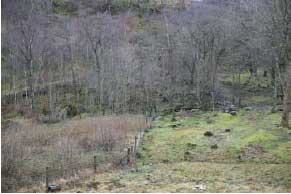
Pedestrians, Cyclists, Equestrians and Community Effects
The Scheme proposals will have a number of potential temporary and permanent effects on the current pedestrians, cyclists, equestrians and communities conditions and several of these effects are deemed to be significant — during both the Scheme construction and operation.
During the Scheme construction phase, the most significant effect would be the temporary severance of the A82 "throughaccess" at Pulpit Rock, affecting all receptors for a number of weeks during the full closure construction period.
During the Scheme operation phase, the most significant beneficial effect will be the removal of the existing traffic light controls on the A82 at Pulpit Rock creating unimpeded journey movements for all vehicle (and nonvehicular borne) receptors; removal of the current traffic queuing patterns; and a safer journey experience.
Specific mitigation measures have been identified to address disruption to receptors using the A82 at Pulpit Rock during the construction period. Temporary traffic management measures will be put in place and will include a diversionary route required for a number of weeks during the full road closure construction period. It is intended that full road closures will be programmed to be outside the main tourist season in an effort to reduce the impact on users of the A82.
During the construction period proposed one-way traffic management measures will involve temporary traffic lights over the full length of the re-alignment works resulting in delays for motorists. During the full road closure construction period when a temporary diversionary route will be required (via the A83/A819/A85), there will be an additional journey distance of approximately 30 miles. A mitigation strategy for emergency service providers will also be put in place to ensure that emergency service provision will not be adversely impacted.
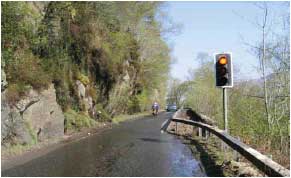
Once the Scheme is operational there will be a permanent beneficial impact associated with the removal of the traffic controls on the A82 at Pulpit Rock allowing two-way flow of traffic that will be of benefit to all users.
Road Drainage and Water Environment
This chapter of the ES assessed the potential effects on water resources as a result of the Scheme. In the context of these proposals the significant water resources were Loch Lomond, a number of small watercourses, a number of small drainage paths, and the groundwater beneath the site. A brief summary of the predicted residual effects from the proposals is noted below.
Surface Water Quality — during construction a number of control measures require to be put in place to reduce the potential for significant quantities of sediment or other typical construction pollutants being discharged into the surrounding water bodies. These measures are considered to be current best practice within the industry, and when implemented with good site management, no significant adverse effects are predicted for the loch, the small watercourses, or the drainage paths. During operation, road run off from a section of the improved A82 will be collected and passed to varying levels of treatment before being discharged indirectly to Loch Lomond via the small watercourses. Based on the inclusion of these treatment measures, there is not predicted to be any significant adverse effects on the existing water quality of Loch Lomond and the small watercourses as a result of the proposals.
Flooding — during the construction works mitigation measures require to be implemented to ensure that the extension / replacement of culverts can be completed whilst maintaining flow in the small watercourses by the provision of temporary flow bypass facilities. The new road drainage infrastructure to be installed for this section of the A82 will attenuate surface water run off to some extent prior to discharge into local watercourses.
Based on these mitigation measures and the surrounding rural area, it is anticipated that there will be no significant adverse effects on the surrounding land with respect to flooding as a result of the proposals.
Geomorphology (form and structure of watercourses) and Hydrology (flow within watercourses) — works consist of a viaduct over the edge of Loch Lomond, extension / replacement of some small culverts, and creation of drainage outlets into the small watercourses. These works will only affect a relatively short length of the loch or the watercourses and are not predicted to have any significant adverse impacts.
Groundwater — there are not predicted to be any significant adverse effects on the overall movement of groundwater in the area from the construction of the Scheme. During construction a number of control measures will require to be put in place to reduce the potential for significant quantities of typical construction pollutants to pass into the shallow groundwater. These measures are considered to be current best practice within the industry, and when implemented with good site management, no significant adverse effects are predicted on the quality of the groundwater. Impacts on the local groundwater quality during the day-to-day operation of the improved section of A82 are not predicted to have a significant adverse effect, based on the road run off treatment measures provided.
With the implementation of the appropriate mitigation measures identified in the Environmental Statement, it is predicted that there will be no significant impacts on the water environment as a result of the Scheme.
Disruption Due to Construction
Traffic delays resulting from the Scheme construction will be associated with the realignment of the existing road. In general, traffic will be controlled by an extension of the one-way system already in place over this section of the A82. It is expected that traffic lights and a one-way working system will be installed for the full length of the site. A mandatory speed limit restriction, potentially of 20 or 30 mph, is expected over the whole length of the works.
In addition to the one-way system full closures of approximately 14 weeks will be required for construction of the tie-ins for the new viaduct to the existing road. During full closures, traffic will be diverted from Crianlarich through the A85-A819-A83 route via Inveraray to Tarbet.
A likely overall construction period of 10 -12 months is expected, with temporary traffic management measures in place for the full period.
Mitigation will include programming of the full road closure period to ensure that it is outside of the tourist season and therefore will have the least possible impact on users of the A82. In addition a strategy will be developed in association with the emergency services to ensure that emergency service provision will not be adversely impacted.
Timely consultation will be conducted with communities between Tarbet and Crianlarich to alleviate as far as possible disruption during the construction period. Furthermore, a coordinated approach will be taken to avoid any other roadworks / maintenance schemes along the A82, A85 and the A83 during the construction period.
The impacts on the local environment will be mitigated by ensuring best practice is adopted wherever possible for all construction activities including mitigation and abatement measures to minimise noise and vibration impacts and impacts on air quality. Restrictions on the Contractor will be agreed with Loch Lomond and the Trossachs National Park Authority. In addition, the Contractor will be required to implement an Environmental Management Plan in order to evaluate the impact of the construction works on the environment and to monitor measures put in place to ensure their effectiveness.
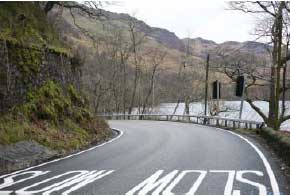
Cumulative Impact Assessment
The cumulative assessment considered the combined effects of individual impacts resulting from the Scheme, i.e. noise dust and visual impacts on one receptor (i.e. a residential property, or an ecological species), addressed here as Scheme only assessment. In addition the cumulative assessment also considered the impact of several projects within a wider area which together have a cumulative effect.
The likely significant impacts concluded from the Scheme only assessment show that the main impacts during construction are noise and air impacts upon a number of receptors. There is also likely to be negative impacts on a number of community receptors including users of the A82 and local residents during the construction phase. In addition, the landscape impacts during both construction and operation of the A82 Pulpit Rock Scheme are predicted to be significant.
With regards to the wider cumulative assessment, which included other potential developments within the study area of Tarbet to Crianlarich, it is concluded that the most significant impact will be on the landscape and also on users of the A82 during construction. Although the potential landscape and visual impacts will be reduced over time as mitigation planting and weathering softens its appearance in the landscape, the scope for mitigation is limited and significant residual effects will occur.
However, the landscape and visual effects as a result of the Scheme represent an acceptable level of change subject to careful mitigation. For ecology and nature conservation, it is concluded that the Scheme will contribute to a number of cumulative impacts on a number of ecological receptors. However, in most cases the magnitude of impact of the Scheme is slight or negligible and therefore not significant and does not contribute to a significant cumulative effect on the ecological integrity of habitats or populations of species occurring in the area.
The combination of all the potential developments is not considered significant for land use, archaeology and cultural heritage or on the water environment. The impacts on pedestrians, cyclists, equestrians and community are considered significant only during the construction phase. The cumulative impacts of disruption due to construction in relation to other potential developments and overlaps in construction programmes can be mitigated through work programming stipulated in construction contracts.

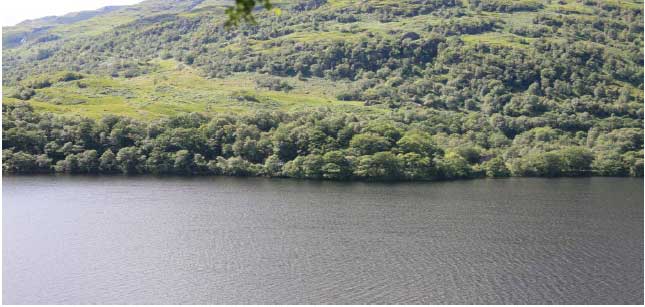
Summer - Existing landscape photograph - Looking south west from the West Highland Way
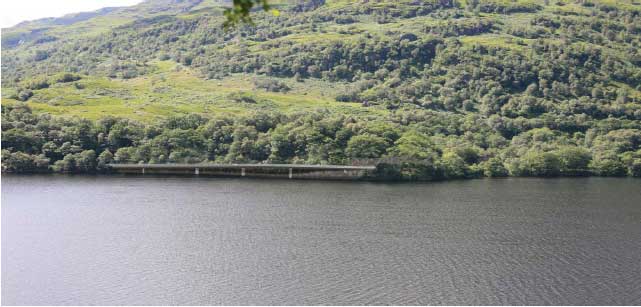
Summer -Photomontage with proposed Scheme - Looking south west from the West Highland Way
WHAT HAPPENS NEXT
Depending on the nature and number of comments received, a Public Local Inquiry into the draft Statutory Orders may be held, together with the hearing of any opinions that may be expressed by members of the public on the Environmental Statement. If a Public Local Inquiry is held, then everyone who has supported, objected to, or made other representations about the draft Statutory Orders and the Environmental Statement will be informed as to the date and venue. Notices confirming the date and venue will appear in the local press at least six weeks prior to any Inquiry commencing.
FURTHER INFORMATION
Copies of the draft Statutory Orders and the Environmental Statement will be available for inspection, during normal business hours, free of charge at the following locations:
Transport Scotland
Buchanan House
58 Port Dundas Street
GLASGOW
G4 0HF
Argyll and Bute Council
Kilmory
Lochgilphead
Argyll
PA31 8RT
Loch Lomond and Trossachs National Park Authority
Carrochan
Carrochan Road
Balloch
G83 8EG
Ardlui Hotel
Ardlui
Loch Lomond
G83 7EB
Copies of the ES can also be purchased from Transport Scotland, Buchanan House, 58 Port Dundas Road, Glasgow, G4 0HF, in paper or electronic format (CD-Rom) at a cost of £150 (paper) and £15 (CD). Copies of the Non-Technical Summary are available free of charge. The ES can also be viewed on the Transport Scotland Website: www.transportscotland.gov.uk .
YOUR VIEWS
If you wish to support, comment on or object to the draft Statutory Orders, or comment on the Environmental Statement, you should write within 6 weeks of the date of publication of the notice for the Environmental Statement.
Director of MTRIPS
Transport Scotland
Buchanan House
58 Port Dundas Road
GLASGOW
G4 0HF